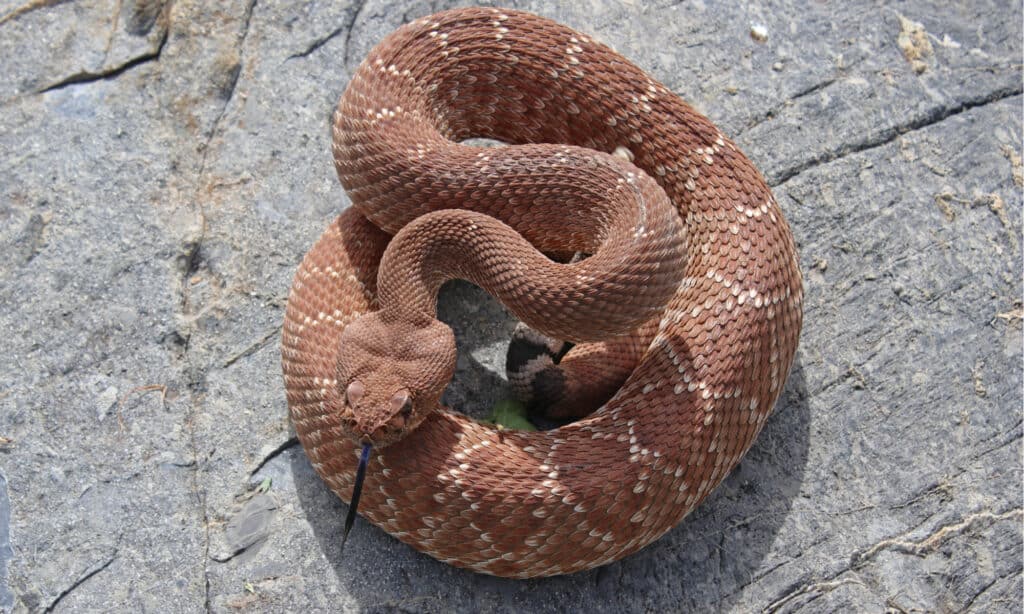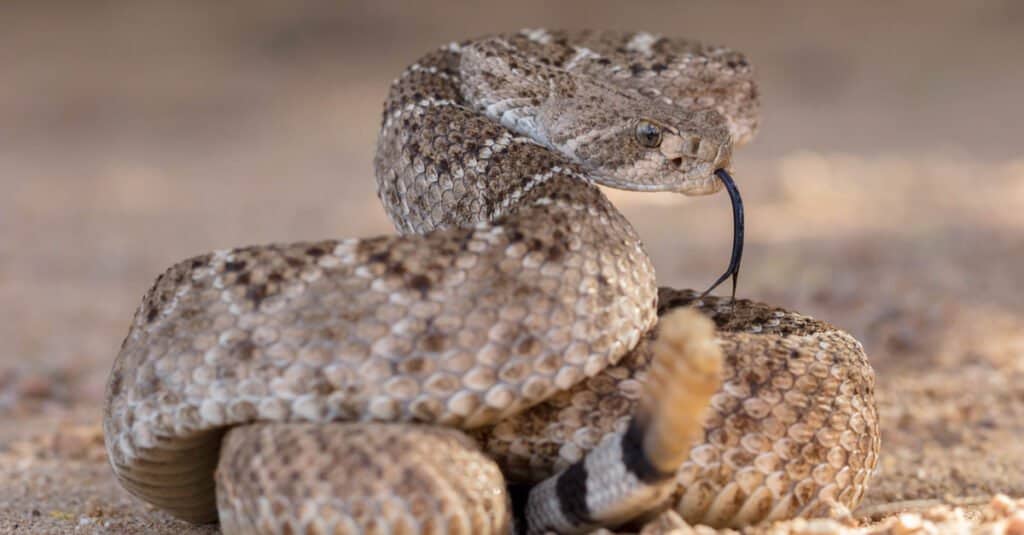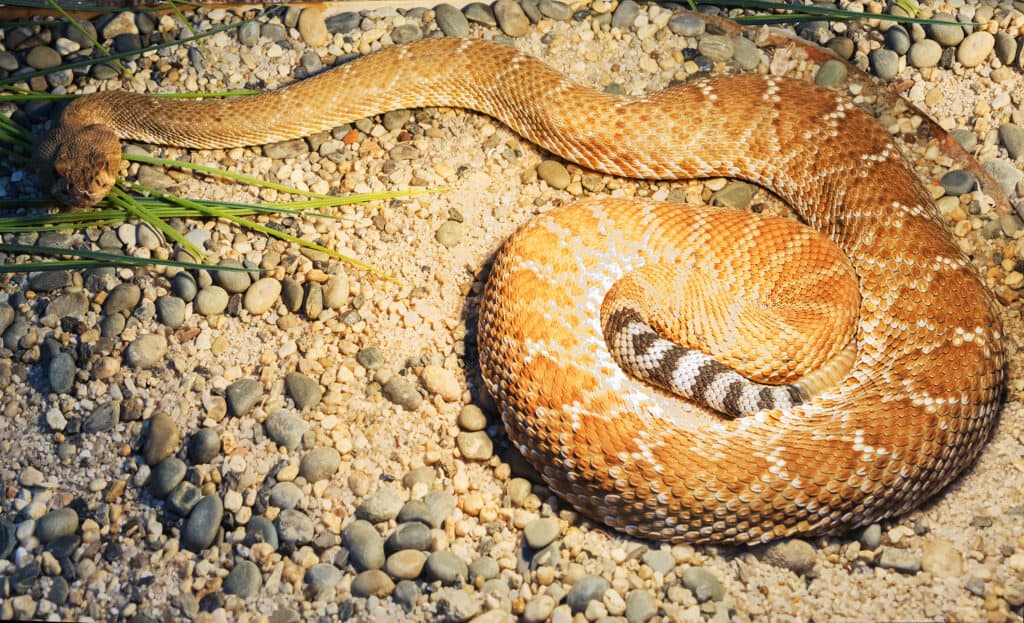One of the most iconic rattlesnakes in the human imagination is the western diamondback rattlesnake—but did you know that this is not the only “diamondback” rattlesnake out there? There are actually three different rattlesnake species that use the name of “diamondback”, including the beautiful and impressive red diamond rattlesnake. This snake goes by many names, such as the red diamondback rattlesnake, the red rattler, and the red rattlesnake. Each of its various names, however, reflects one of its most prominent characteristics: its beautiful red coloring.
Like its two diamondback cousins, the red diamond rattlesnake is a long and heavy snake that lives in the United States. But just how big can it get? Let’s take a closer look at this impressive snake and discover the largest red diamond rattlesnake ever recorded!
What Do Red Diamond Rattlesnakes Look Like?

Creeping Things/Shutterstock.com
Red diamond rattlesnakes are big snakes with heavy bodies that look very similar to western diamondback rattlesnakes. However, the main difference between these snakes is that red diamond rattlesnakes have reddish- or reddish-brown bodies. This is reflected in their scientific name, Crotalus ruber, as the Latin word “ruber” means “red”.
Like other diamondback rattlesnakes, these snakes also have diamond-shaped patterns running along the middle of their backs, with each diamond marking outlined with light edges. In addition, the end of a red diamond rattlesnake’s tail has distinct black and white alternating rings. They also have rattles at the end of their tails, which are made up of keratin segments. These segments rattle against one another when the snake vibrates its tail.
As a type of pit viper, red diamond rattlesnakes have large, wide heads that are twice as wide as the snake’s neck and shaped like a big, rounded triangle. They have large eyes with vertical or elliptical pupils, much like a cat. Behind each eye is a light-colored, diagonal stripe that runs to the back of the snake’s head. There are two heat-sensing organs that look like small holes or a second pair of nostrils below the snake’s eyes. These organs are called “loreal pits”, and they help the snakes to sense and build a heat image map in their brains, allowing them to “see” the world around them, even in the dark.
The Largest Red Diamond Rattlesnake Ever Recorded
When they are born, baby red diamond rattlesnakes are around 12 inches long with grayish colored bodies. As they grow and mature, however, they gain more of their namesake red coloring. Adult red diamond rattlesnakes are usually between 24-54 inches in length and can weigh several pounds.
Snakes living within coastal environments tend to grow larger than those in mountain and desert habitats. Occasionally some of the larger male snakes may grow 58-59 inches, but this is quite rare. However, the largest red diamond rattlesnake ever recorded went well beyond that length, growing to at least 64 inches long!
How Does the Largest Red Diamond Rattlesnake Compare to Other Types of Diamondback Rattlesnakes?

Alexander Wong/Shutterstock.com
Although 64 inches is an astounding length for a red diamond rattlesnake, their two diamondback rattlesnake relatives often grow much larger. For example, the iconic western diamondback rattlesnake grows between 4-6 feet on average, and in some cases even up to 7 feet long!
Of course, neither the red diamond rattlesnake nor the western diamondback rattlesnake can compete with the enormous eastern diamondback rattlesnake. The eastern diamondback rattlesnake is the largest rattlesnake in the world, with an all-time record size of 7.9 feet long and 34 pounds!
Where Do Red Diamond Rattlesnakes Live?

iStock.com/User10095428_393
Red diamond rattlesnakes live in the southwest portion of California down into the peninsula of Baja California, and on several islands in the Gulf of California. Red diamond rattlesnakes live in environments that range from the desert to the mountains, as well as cooler regions along the coast. They prefer habitats with rocky hillsides, cactus patches, sage scrub, outcrops, and the chaparral of the foothills. Although they generally stick to the ground, some snakes will occasionally climb up into low-growing cacti, shrubs, and sage as well.
Like many snakes, red diamond rattlesnakes create their own personalized “mental maps” of their surroundings, which allows them to return to the areas over time. These snakes, however, do not tend to venture too far, keeping a smaller home range that is typically not more than a couple of miles.
Are Red Diamond Rattlesnakes Dangerous?

Creeping Things/Shutterstock.com
Unlike the notorious western diamondback rattlesnake, red diamond rattlesnakes are calm with a very mild temperament. These snakes rarely bite and will try to slither under cover or into rock crevices and rodent burrows when they feel threatened. Red diamond rattlesnakes also have one of the least potent venoms among all rattlesnakes. However, they can deliver a large amount of venom in a single bite, which can be fatal if not treated properly. Fortunately, red diamond rattlesnakes rarely bite, as retreating is their preferred defense against threats.
Interestingly, the venom of red diamond rattlesnakes increases as they age, so a bite from an adult snake has the potential to be much worse than that of a younger snake. Red diamond rattlesnake bites can cause massive swelling, discoloration, intense pain, nausea and vomiting, and blood disruption.
What Do Red Diamond Rattlesnakes Eat?
Although red diamond rattlesnakes can be dangerous, they do not hunt or actively seek out humans. These snakes eat mammals like woodrats, ground squirrels, and rabbits, as well as lizards, other snakes, and sometimes birds. They are ambush hunters that lie in wait for their prey to pass by before striking.
Up Next
- Discover The Largest Rattlesnake Ever
- Discover The Largest Eastern Diamondback Rattlesnake Ever
- The Top 10 Most Venomous Snakes In The World
The post Discover the Largest Red Diamond Rattlesnake Ever Recorded appeared first on AZ Animals.
from Animal News, Facts, Rankings, and More! - AZ Animals https://ift.tt/iYyEqzK